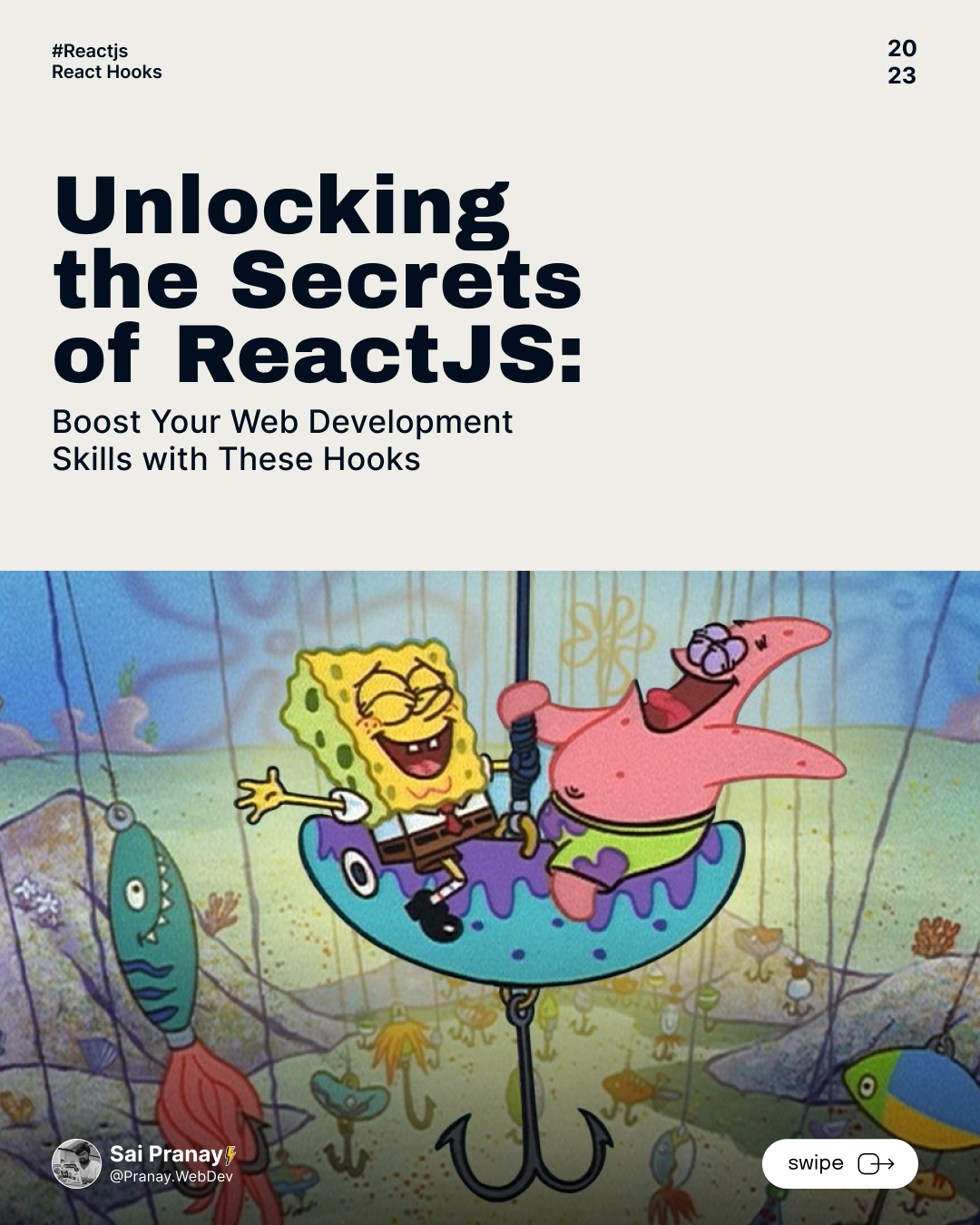Unlocking the Secrets of ReactJS: Boost Your Web Development Skills with These Hooks
 Sai Pranay
Sai Pranay
ReactJS has become a popular library for building user interfaces due to its flexibility, scalability, and reusability. However, as projects become more complex, managing state and event handling can become challenging. Fortunately, ReactJS Hooks provide a solution to this problem. In this blog, we'll explore how ReactJS Hooks can simplify state management and event handling in functional components, and improve your web development workflow. We'll cover popular Hooks, including useState, useEffect, useContext, and useReducer, and provide code examples to help you understand how they work. So let's dive in and unlock the secrets of ReactJS Hooks!
What are Hooks?
Hooks are a new feature in ReactJS that allow you to use state and other React features without writing a class. They provide a way to reuse stateful logic between components. Hooks let you use more of React's features in functional components, so you can use functions to accomplish everything that was previously done with classes.
In essence, Hooks are functions that allow you to "hook into" React state and lifecycle features from functional components. There are several built-in Hooks provided by React, including useState, useEffect, useContext, and useReducer.
By using Hooks, you can simplify your code, making it more modular and reusable. Instead of writing separate classes for each feature, Hooks allow you to encapsulate stateful logic in separate functions that can be reused across multiple components.
In the next sections, we'll explore the most commonly used Hooks in ReactJS and provide code examples to help you understand how they work.
useState Hook
The useState Hook is one of the most commonly used Hooks in ReactJS. It allows you to add state to functional components. State is a data structure that allows components to manage and store data. In class components, state is managed through the constructor method.
In functional components, the useState Hook provides a way to add state. It takes an initial value as an argument and returns an array with two elements: the current state and a function to update the state. Here's an example:
import React, { useState } from 'react';
function Counter() {
const [count, setCount] = useState(0);
return (
<div>
<p>Count: {count}</p>
<button onClick={() => setCount(count + 1)}>Increment</button>
</div>
);
}
In this example, we define a functional component called Counter. We use the useState Hook to add state to the component by initializing the count to 0. We then display the current count value and a button that updates the count using the setCount function.
Whenever the setCount function is called, React will automatically re-render the component with the updated count value.
The useState Hook provides a simple and efficient way to manage state in functional components. You can use it to manage any type of data, including strings, numbers, objects, and arrays.
useEffect Hook
The useEffect Hook is another commonly used Hook in ReactJS. It allows you to manage side effects in your functional components. Side effects are any changes made outside the component that affect its behavior, such as fetching data, updating the DOM, or interacting with other components.
The useEffect Hook takes two arguments: a callback function and a dependency array. The callback function is executed after every render of the component. The dependency array is an optional argument that tells React when to re-run the effect. Here's an example:
import React, { useState, useEffect } from 'react';
function UserProfile(props) {
const [user, setUser] = useState(null);
useEffect(() => {
fetch(`https://api.example.com/users/${props.userId}`)
.then(response => response.json())
.then(data => setUser(data))
.catch(error => console.log(error));
}, [props.userId]);
return (
<div>
{user && (
<div>
<h1>{user.name}</h1>
<p>{user.email}</p>
</div>
)}
</div>
);
}
n this example, we define a functional component called UserProfile. We use the useState Hook to add state to the component by initializing the user to null. We then use the useEffect Hook to fetch user data from an API endpoint. The effect is re-run whenever the props.userId value changes.
Once the data is fetched, the setUser function is called to update the component's state with the new user data. Finally, we display the user's name and email in the component.
The useEffect Hook provides a simple and efficient way to manage side effects in your functional components. You can use it to fetch data, update the DOM, or interact with other components without having to write complex class components.
useContext Hook
The useContext Hook is a powerful Hook in ReactJS that allows you to manage global state in your components. Global state refers to data that can be accessed by any component in your application.
Traditionally, global state was managed using libraries like Redux. With the useContext Hook, you can manage global state without having to add another library to your project.
The useContext Hook takes a context object as its argument and returns the current value of the context. Here's an example:
import React, { useContext } from 'react';
import { UserContext } from './UserContext';
function UserProfile() {
const user = useContext(UserContext);
return (
<div>
<h1>{user.name}</h1>
<p>{user.email}</p>
</div>
);
}
In this example, we define a functional component called UserProfile. We use the useContext Hook to access the user object from a context object called UserContext. The UserContext object is defined in another file and exported as a React context object using the createContext function.
By using the useContext Hook, we can access the UserContext object without having to pass it down as a prop through multiple components.
The useContext Hook provides a simple and efficient way to manage global state in your functional components. You can use it to access data and functions that are shared across multiple components without having to add another library to your project.
useReducer Hook
The useReducer Hook is another powerful Hook in ReactJS that allows you to manage complex state in your applications. It provides an alternative to the useState Hook for managing state that involves multiple sub-values or has complex transitions.
The useReducer Hook takes two arguments: a reducer function and an initial state value. The reducer function takes two arguments: the current state and an action object, and returns the new state. Here's an example:
import React, { useReducer } from 'react';
function reducer(state, action) {
switch (action.type) {
case 'ADD_ITEM':
return { ...state, [action.payload.id]: action.payload.quantity };
case 'REMOVE_ITEM':
const newState = { ...state };
delete newState[action.payload.id];
return newState;
default:
return state;
}
}
function ShoppingCart() {
const [items, dispatch] = useReducer(reducer, {});
const handleAddItem = (id, quantity) => {
dispatch({ type: 'ADD_ITEM', payload: { id, quantity } });
};
const handleRemoveItem = (id) => {
dispatch({ type: 'REMOVE_ITEM', payload: { id } });
};
return (
<div>
<h1>Shopping Cart</h1>
<ul>
{Object.keys(items).map((id) => (
<li key={id}>
Item {id}: {items[id]}
<button onClick={() => handleRemoveItem(id)}>Remove Item</button>
</li>
))}
</ul>
<button onClick={() => handleAddItem(1, 1)}>Add Item 1</button>
<button onClick={() => handleAddItem(2, 2)}>Add Item 2</button>
</div>
);
}
In this example, we define a functional component called ShoppingCart. We use the useReducer Hook to manage the items state. The reducer function is used to update the items state based on the action type passed to the dispatch function.
We define two action types: 'ADD_ITEM' and 'REMOVE_ITEM'. When an item is added, we use the 'ADD_ITEM' action to add the item to the items state. When an item is removed, we use the 'REMOVE_ITEM' action to remove the item from the items state.
We define two functions to handle adding and removing items. These functions use the dispatch function to call the appropriate action type.
Finally, we render the items list using Object.keys to get an array of the keys in the items object. We then map over this array to render each item and a button to remove it. We also render two buttons to add items to the cart, with different ids and quantities.
By using the useReducer Hook, we are able to easily manage the state of the shopping cart and make updates to the items list as needed. The code is also more concise and easier to read than if we were using the useState Hook or managing state manually.
In conclusion, React Hooks provide a powerful and flexible way to manage state and lifecycle methods in ReactJS applications. With Hooks like useState, useEffect, useContext, and useReducer, developers can write more concise and reusable code that is easier to maintain and update.
By understanding and implementing these Hooks in your web development workflow, you can boost your productivity and create more complex and responsive web applications with ease. Whether you are a seasoned React developer or just starting out, learning how to use Hooks is a valuable skill that will enhance your programming toolkit.
So what are you waiting for? Start exploring the world of React Hooks today and see how they can take your web development skills to the next level!
Subscribe to my newsletter
Read articles from Sai Pranay directly inside your inbox. Subscribe to the newsletter, and don't miss out.
Written by

Sai Pranay
Sai Pranay
I'm Sai Pranay, a design-minded front-end developer focused on building beautiful interfaces & experiences